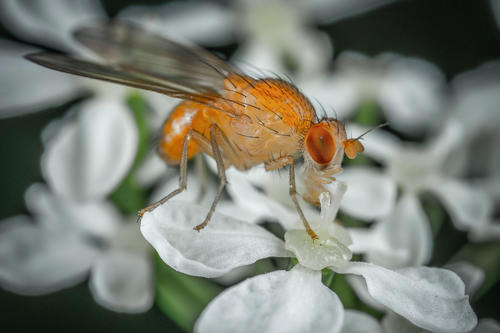The Role of Chance in the Development of the Brain
Emmy Noether Fellow and Group Leader Gerit Linneweber investigates individuality using the fruit fly
Dec 08, 2021
A whim of nature? Random processes play a role in the development of the brain. Even twins who grow up together have differences in appearance and behavior.
Image Credit: pexels-cottonbro
Fruit flies are tiny, annoying, and usually appear in bulk. Once there is a smell of ripe fruit in the air, they cannot be stopped. The little flies do not have the best reputation, but besides being adored by insectivores and carnivorous plants, they are highly valued by another “species” – biologists.
The fruit fly Drosophila melanogaster is a popular model organism because it shares many features that are built simpler than most other living organisms. When the fly is full grown at two millimeters in length, its brain consists of only around 100,000 nerve cells. That sounds like a lot for such a tiny creature, but it is not much more than the proverbial fly speck in relation to the approximately 85 billion neurons of the human brain.
Gerit Linneweber, who is currently setting up an Emmy Noether junior research group at Freie Universität Berlin, is investigating the phenomenon of individuality using the fruit fly. Up till now, researchers commonly believed that only vertebrates had individuality. It now seems that not all fruit flies act the same way. Very simple behavioral experiments can show this individuality: A fruit fly is placed for 15 minutes in an arena that contains nothing more than a white platform with two identical black bars on opposing sides. This is a strong visual stimulus for the insects that were bred in a low-contrast environment.
Fruit Flies Have Their Own Character
“Some of the flies have an intense reaction and keep walking back and forth between the bars. Others ignore them completely and explore the entire platform,” explains the neurobiologist Linneweber. “Even if we repeat the tests several times, the flies behave exactly as they did before.” This is not due to a visual defect. The indifferent flies are simply not interested. Different individuals have different preferences.
What causes the difference? It depends on the degree of symmetry of on average 28 specific nerve cells that connect the two halves of the brain. After each experiment, the researchers examined this brain region under a microscope. “Some flies really have 14 neurons on each side, while with others, we find a ratio of 16 to 4. Interestingly, those with the strong asymmetry react particularly strongly to visual stimuli,” explains Dr. Linneweber. The researchers assume that asymmetrical brains make it easier to choose between two equal options by breaking the symmetry between identical stimuli.
Artificial Asymmetry
Some of the flies are put through a second experiment for which they are given a type of “eye patch.” These “test subjects,” blinded on one side by a small dot of paint, now react much more strongly to the bars than before. Dr. Linneweber says, “With this experiment, we can artificially create asymmetry at a higher level.”
How does asymmetry arise in the brain? Simply put, there are long and short neurons, as Linneweber explains. How many of them develop in each case is decided by a signal cascade during development, called the notch signaling pathway. “It amplifies the differences between cells during development. With a lot of notch, there are no longer any long neurons in the end; with little notch, almost only long neurons are formed.”
This small insect is widely used in research: the fruit fly Drosophila melanogaster.
Image Credit: pexels-egor-kamelev
Does the asymmetry have any advantages for the flies? “Not in our experiment. But the fact that the genetic code is not translated one to one into the phenotype is an evolutionary strategy.” Dr. Linneweber explains as follows: Assuming genome variant A (genotype A) would only result in individuals of appearance A (phenotype A) and genotype B accordingly only in phenotype B. Suppose the environmental conditions changed and A would now have an advantage. Then these individuals would prevail over time, but the Bs would die out. If the genotype-phenotype mapping is imprecise – in other words: a broad spectrum of variants of phenotypes A and B is created – the number of Bs would decrease, but phenotype B would never completely disappear.
The asymmetry in the fly’s brain develops by chance, but it is still controlled by its genes. “In Drosophila, we usually see 14 of the long neurons in this area of the brain. Certain genotypes, however, give rise to a maximum of five neurons, but within these five anything from zero to five is possible.” At 14, the range is correspondingly wider, from zero to 14. The genetic code, therefore, sets the boundaries for the random process. Dr. Linneweber estimates that a maximum of one-third of the flies have perfect symmetry regarding these neurons.
Similarities to Humans
Do people also have asymmetries in their brains? Dr. Linneweber says, “Yes, there are indications that random processes also play a role in the wiring of our brain.” Even if they grow up separately, identical twins have striking similarities that go far beyond their physical appearance. For example, they might both prefer a particular musical instrument. “But even with twins who grow up together and therefore under the same environmental conditions, there are differences in behavior, but also in appearance. They look very, very similar, but are never exactly the same,” Linneweber stresses.
Fingerprints are a typical example of a random process: They are different on both hands, and identical twins also have different fingerprints. From a biological point of view, there would be no advantage if they were identical. “That is why there is no evolutionary pressure for perfect symmetry.”
Even if genetics and the environment together determine to a large extent who we are, every individual is also controlled by random processes. Is that unsettling or fascinating? Probably both.
Gerit Linneweber now aims to investigate how the asymmetry of the neurons leads to different signals in the fly’s brain and how individuality affects learning. “So far, we have only examined the innate behavior of Drosophila. Now we want to know how well some flies learn compared to others,” he explains. “Without judging them, of course,” he adds with a laugh.
This text originally appeared in German on October 2, 2021, in the Tagesspiegel newspaper supplement published by Freie Universität Berlin.
Further Information
Dr. Gerit Linneweber, Emmy Noether Fellow and Group Leader, Institute of Biology, Freie Universität Berlin, Email: gerit.linneweber@fu-berlin.de


